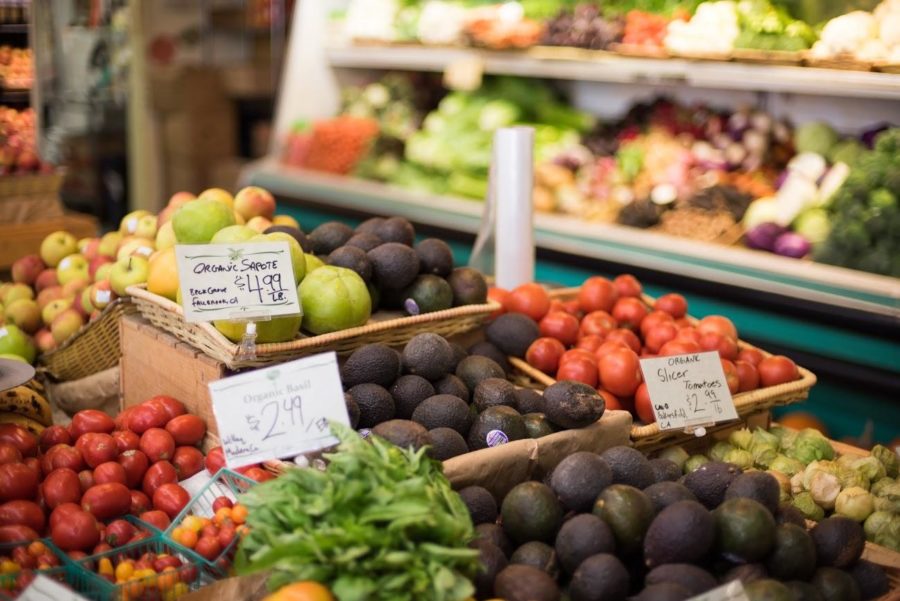Santa Rosa Junior College student Nick Sterba’s attitude toward food reflects many college student’s nutritional prerogatives. “I just eat whatever’s around me or cheapest,” Sterba said.
Nothing magical happens inside your body that will compensate for washing down pizza with a coke. We are what we eat. That’s simple chemistry and the inescapable truth.
“Education is power and a lot of people are unaware. It’s really important we have that education in our system,” said SRJC student Deardhra McGeough-Pendergast. With that in mind, let me drop some knowledge on you.
Hydration
Feeling tired and irritable? A little confused? Maybe that’s just your personality, but chances are you’re mildly dehydrated. Thirst sensation is a delayed reaction that only kicks in once you’re a few cups low on water. For the average sedentary student, eight cups of water a day is a minimum. However, if moderately or extremely active, your water needs will spike. Like many things in life, don’t trust what you feel – especially when it comes to hydration. Rely on hard facts. Trust your pee. Urine should not resemble fall colors, but should rather be light yellow to clear in color.
“If people are trying to lose weight, drinking water throughout the day is great because people often mix up hunger and thirst,” said SRJC nutrition instructor Tammy Sakanashi. Whenever consuming alcohol or caffeine, remember drinking water is essential to combat the diuretic effects of those substances.
Pro Tip: Carry a reusable water bottle and set a goal to drink the bottle by a certain time. Then repeat. Drinking water as a habit may seem annoying to start, but your body will thank you for it.
Calories
Calories, or kcals, are units of energy that measure our food. The average daily recommended adult intake is around 2,000, but this number varies greatly based on gender, activity, basal metabolic rate and age. Lipids (fats/oils) pack nine kcals/gram, proteins and carbohydrates hold four calories per gram and alcohol contains seven calories per gram.
To maintain a consistent body weight, the amount of calories you consumed needs to be equal to the amount of calories you burn. Whether you’re hoping to lose a few pounds to avoid ripping out of your favorite skinny jeans or just hoping that your “low and loose” fitting pants don’t resemble tights, the sure way to lose weight is to burn calories through exercise and eat less than you burn.
For a reference, one pound of fat is worth around 3,500 calories. However, if you’re the emaciated kid who is trying to get shredded overnight, or simply want to gain some healthy weight, you need a caloric surplus.
Lipids
Eating fat doesn’t make you fat. Eating too many calories and not exercising will. Fat should account for 20-35 percent of daily calories and is an important source of stored energy. Fat is also used for body insulation, organ body-armor, skin, hormones, reproductive system and nervous systems.
Not all fats are created equal. Your diet should favor unsaturated fats found in seeds, nuts, avocados and olive oil.
The reason these are preferred to high levels of saturated fats found in animals is because they don’t clog your arteries with plaque build-up (atherosclerosis), cause high blood pressure, heart disease or strokes. For these reasons, you should limit your intake of dairy fat (cheese, cream, butter) and animal fat. One important fatty acid essential for health is Omega-3, which helps reduce inflammation, speed muscle recovery and lower blood triglyceride (fat) levels. Main sources include: fatty fish (6 oz./week), chia seeds or ground flax seeds.
Pro Tip: If dieting to lose weight, eat a few well-placed handfuls of nuts or other good fats throughout the day. It will give you satiety for longer periods of time. It takes three to four hours for fat to leave the stomach.
Carbohydrates
Carbohydrates divide into two groups: simple sugars and complex carbohydrates. The main function of carbohydrates is to provide a constant supply of sugar in your blood stream to fuel muscles and the brain, though if not readily used it will convert to fat and be used as fuel during fasting blood glucose levels. Forty-five to 65 percent of caloric intake should be from carbohydrates – mainly from complex carbs.
Often people’s diets target carbs as the enemy to weight loss and seek to eliminate them from the diet, but the brain can only metabolize carbs for energy – perhaps if they ate a bagel they would understand this. Complex carbs are just long chains of simple sugars that are broken down at a slower rate in your digestive tract. Sources of complex carbs are potatoes, grains, oats, vegetables, legumes, pasta and bread.
Simple sugars are often found in fruit and sweetened beverages. The liver and pancreas regulate blood sugar through negative feedback loops using the hormones insulin and glucagon to increase or decrease blood glucose levels. The reason to limit simple sugars in your diet is because your body absorbs them quickly, which will reduce satiety and lead to increased calorie consumption, resulting in weight gain. Large amounts of simple sugars cause insulin spikes in blood, which leads to inflammation. Chronic elevated levels of insulin cause reduced sensitivity to insulin, resulting in high blood-glucose levels, which can lead to blindness and loss of extremities (fingers/toes) because of cellular damage.
Pro Tip: Cut back on soda and sugary drinks throughout your day and opt for water instead. When feeling the urge to indulge with candy or donuts, try a whole wheat bagel or toast. If you’re looking for a sugar-free way to sweeten food or drinks, try stevia. Stevia is a natural sweetener 40 times sweeter than sugar with little caloric significance and no negative side effects.
Protein
Protein is essential for muscle growth, enzymes, cell function, immune function, healing, growth and can also be used for energy. About 10-35 percent of calories should be from protein. Good sources are lean meats, fish, low-fat dairy, eggs, legumes and lentils. For those looking to gain muscle or who are recovering from injuries, protein needs will increase.
If you’re a vegetarian/vegan, adequate protein intake is a priority. Prime sources are legumes, lentils, split peas, soy and protein rich grains such as quinoa. For lightly active individuals, a recommended intake is 1.2 grams protein/kilogram body weight (2.2 pounds = 1 kilogram) and for body builders 1.6 gram/kilogram body weight.
Quite often, “bro science” touts the necessity of heaps of protein powder to get “gains.” The truth is, if you consume too much protein, it will get peed out, turned to fat or burned as energy, causing a buildup of ketones that make your body stink while giving you acetone breath. Eating too much protein can also cause kidney damage from having to filter out the excess.
Pro Tip: You won’t lose all your gains if you miss your hourly protein shake.
Vitamins and Minerals
Vitamins and minerals are not used for energy, but serve important functions in the body. Minerals are important for bone, teeth, skin, muscle function, body water balance, immune function and transporting oxygen to cells. Vitamins are important for metabolism, neural development, blood clotting, antioxidants, immune function, skin, hair and mineral absorption among other functions. The best way to consume all the necessary vitamins and minerals is through diversity of healthy eating habits and incorporating large amounts of vegetables and fruits in your diet.
For natural foods, “The more colorful, the better. Going to a more plant-based diet is always better,” said SRJC nutrition instructor Jill Tarver. Multi-vitamins are a good catch-all at the end of the day, but you should rely on getting nutrients naturally through food, not pills.
Pro Tip: Eat the rainbow of fruits and vegetables, not the Skittles rainbow.
Healthy Shopping on a Budget
Good news for those of you living paycheck-to-paycheck. Eating healthy isn’t just for people who can afford to shop at Whole Foods. To get healthy calories at a good price your best options are lentils, rice, split peas, potatoes, pasta, beans and whole grain breads. These are the foundation of your diet. Once you save money with the above options, use the leftover dollars to buy fruit and vegetables.
Citrus, bananas, apples, greens, broccoli and bell peppers are good places to start. Frozen produce is harvested at peak ripeness and are flash frozen to preserve the nutrients. These store well and are usually cheaper.
Pro Tip: The cheapest place in Santa Rosa to shop is Grocery Outlet. However, don’t be tempted by the cheap boxed pizzas and soda sold in bulk. You’re there for health at budget pricing; once you get what you intended, get out of there quick. Community Market by SRJC is also a good choice for a quick healthy snack close to campus.
Food Prep
The best way to stay on track for nutrition and saving money is to pack your own food for school and work. The key is to allow time to prepare your day’s food the night before or early in the morning. Some strategies also include making multiple meals over the weekend to store for stressful weekdays. By packing your own food, you can avoid the vending machine traps, save money and maintain optimal nutrition.



